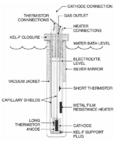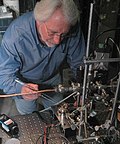Cold fusion
Cold fusion is a hypothesis about nuclear fusion at room temperature and normal pressure.[1] Nuclear fusion is how many nuclei, the center of an atom, containing protons and neutrons, are forced together to form a heavier nucleus (singular of nuclei) and during that process, energy is released. Some scientists hope that this may be Earth's future energy source, but most scientists do not agree.
For nuclear fusion to take place, a large amount of energy is needed. With this energy, the atoms are pushed together, which are repelled by the electrostatic force (a force between protons which are particles in the nucleus of the atom and have a positive electrical charge). But once this force is overcome and the nuclei are pushed close enough together, another much more powerful force will take over: the strong nuclear force. It only operates at short distances, so when the nuclei are close enough, they attract each other because of the strong nuclear force which is stronger than the electrostatic force. It is hoped that the energy released by cold fusion is much greater than the energy used to push the atoms together.
In 1989 two scientists, Stanley Pons and Martin Fleischmann, published a paper in Nature, a reputable science journal, claiming to have created cold fusion. This was a very important story at the time. Other scientists were not able to repeat their experiments. This is why cold fusion is not generally accepted by scientists at the moment. Several dozen scientists are still working on cold fusion research. They publish in peer-reviewed journals and other academic sources regularly, but most are not convinced.
At the time, Cold fusion caused a large disruption in the scientific community, culminating on May 1st 1989 at a session of the American Physical Society where some scientists who unable to reproduce the original results successfully cast Cold fusion out of main stream science.
Cold Fusion Media
Diagram of an open-type calorimeter used at the New Hydrogen Energy Institute in Japan
Cold fusion apparatus at the Space and Naval Warfare Systems Center San Diego (2005)
"Triple tracks" in a CR-39 plastic radiation detector claimed as evidence for neutron emission from palladium deuteride
Michael McKubre working on deuterium gas-based cold fusion cell used by SRI International
References
- ↑ "Cold fusion", Wikipedia, 2024-08-03, retrieved 2024-08-30
Other websites
| Wikimedia Commons has media related to Lua error in Module:Commons_link at line 62: attempt to index field 'wikibase' (a nil value).. |
- Barnhart et al. (2009) "Technology Forecast: Worldwide Research on Low-Energy Nuclear Reactions Increasing and Gaining Acceptance," Defense Analysis Report DIA-08-0911-003, U.S. Defense Intelligence Agency
- Marwan, Jan and Krivit, Steven B., eds., Low energy nuclear reactions sourcebook (American Chemical Society/Oxford University Press, 2008; ISBN 978-0-8412-6966-8)
- Kitamura, A. et al. (2009) "Anomalous effects in charging of Pd powders with high density hydrogen isotopes" Physics Letters A 373(35):3109-12 doi:10.1016/j.physleta.2009.06.061
- Kim, Y.E. (2009) "Theory of Bose–Einstein condensation mechanism for deuteron-induced nuclear reactions in micro/nano-scale metal grains and particles,"[dead link] Naturwissenschaften 96(7):803-11.
- Szpak S, Mosier-Boss PA, Gordon FE (2007) "Further evidence of nuclear reactions in the Pd–D lattice: emission of charged particles"[dead link] Naturwissenschaften, vol. 94 pp. 511–514.




